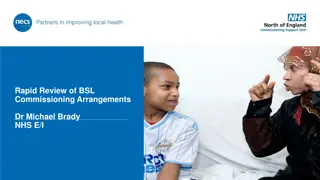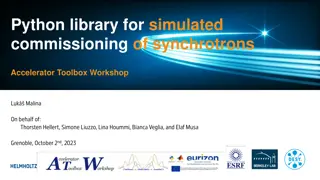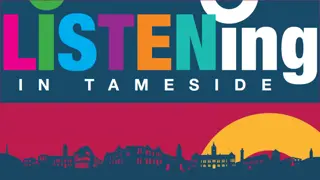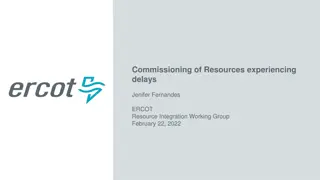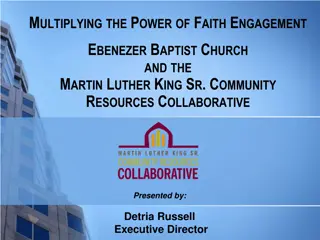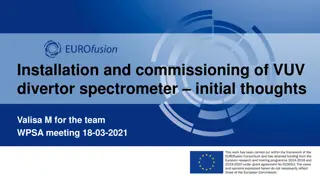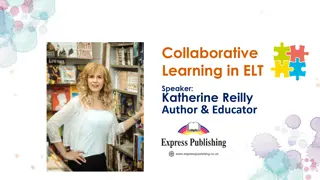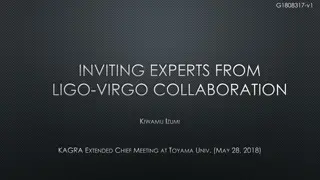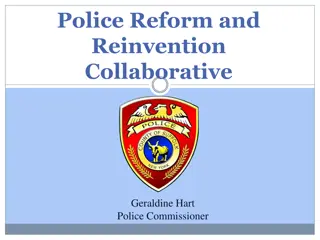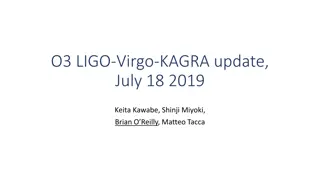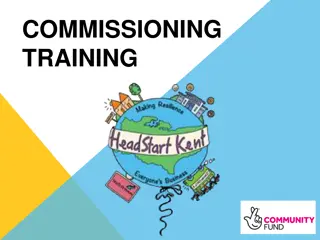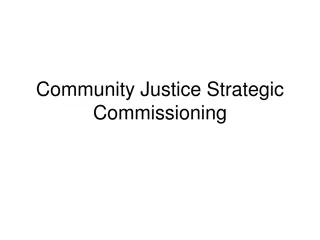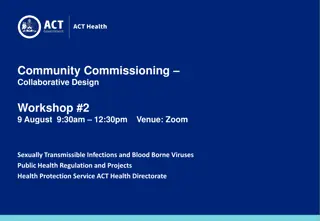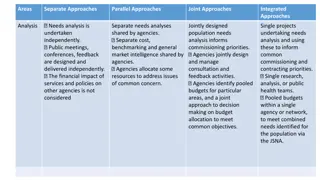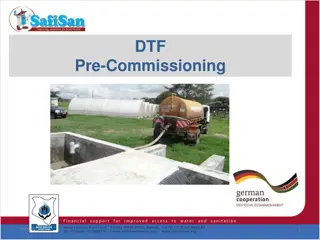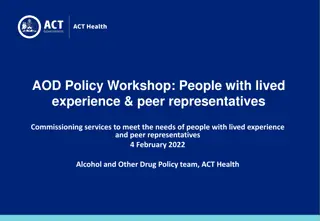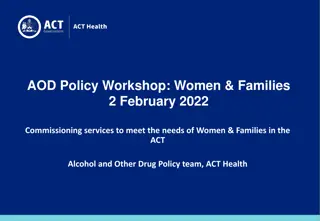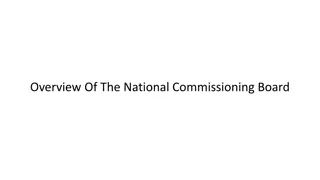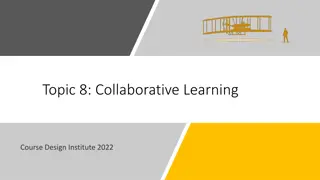Guide to Collaborative and Engaging Activities for Commissioning
This guide provides insights on collaboration in commissioning, emphasizing transparency, inclusivity, and shared decision-making. It outlines methods for collaborative design, such as co-design, co-production, and incorporating lived experiences. The guide helps in selecting activities that engage all participants, share information, collect input, and bring people together for effective collaboration throughout the commissioning cycle.
Download Presentation

Please find below an Image/Link to download the presentation.
The content on the website is provided AS IS for your information and personal use only. It may not be sold, licensed, or shared on other websites without obtaining consent from the author. Download presentation by click this link. If you encounter any issues during the download, it is possible that the publisher has removed the file from their server.
E N D
Presentation Transcript
ACT Government Commissioning for Outcomes GUIDE Selecting collaborative and engaging activities for commissioning
Welcome Use this guide to: Understand what collaboration in commissioning is This is a handy guide to help you find ways to collaborate and engage through the commissioning cycle. Inform selection of collaboration and engagement activities as a commissioner planning a cycle or in collaboration with sector or service partners Understand how to use a mix of different activities to enhance the participation experience and the value of the input and insights
What we mean by collaborative design Anyone interested in a commissioning cycle should be able to see when activities are occurring, read a listening report and understand where the cycle is up to. This is about being transparent and inclusive. As a participant, in most commissioning cycles, you should be able to listen to, and interact with other participants. Participants are demonstrably representative This can include hearing the voices of people with lived experience, sharing collaborative space with people with lived experience or seeing their contributions to service redesign. Processes are transparent Together, government and the sector should use evidence to test and choose how to redesign a service or provide a solution There are fewer fundamental constraints on what options might be pursued Importantly, we have a clear problem or framing statement and an open opportunity to explore both the challenges/problem(s) and the options to meet the need. To evaluate our practice, we use this definition in the four points above to test whether a particular process is consistent with our intended approach. Shared decision making occurs
Understanding collaboration COLLABORATION METHODS OR ACTIVITIES CO-DESIGN CO-PRODUCTION LIVED EXPERIENCE Designing with, not for. It challenges the imbalance of power held by people who make decisions, prioritises relationships, brings lived experience voices and stakeholders together with governments and uses creative tools to examine challenges, problems, or systems for improvement. A relationship where government, sector partners and community members collaboratively design and deliver health and support services across the full commissioning cycle. Recognises that all parties have vital contributions to make in the design and delivery of services. Personal knowledge about the world gained through direct, first-hand involvement in everyday events rather than through representations constructed by other people. People with lived experience can participate in collaborative activities too. Creative thinking tools or activities used to generate collaboration via reflection, critical thinking, discussion, brainstorming, prioritisation etc
Do these four (4) things when selecting activities REACH ALL IDENTIFIED PARTICIPANTS SHARE INFORMATION COLLECT AND COMPILE INPUT BRING PEOPLE TOGETHER Participants can provide input and collaborative outputs are captured and reflected Participants can see and hear other participants and we guided through collaborative activities together. Participant needs are considered in the selection of activities and methods. Participants have the information they need to participate in a meaningful way
Select a mix of activities from INFORMING to COPRODUCTION Government partners with service provider to identify ways for young people to receive support. COMMISSIONING HAPPENS HERE COLLABORATION HAPPENS HERE Service providers co-host a series of events with people with lived experience to design new health and wellbeing services
Description Benefits Limitations One stop place available 24/7 to all participants and the ability to link and update. Need to ensure accessibility of all documents and images. WEBPAGE Central platform for all information related to the commissioning process. SHARING INFORMATION Relevant for most participants with simple baseline information or can be tailored and targeted. Need to ensure accessibility of all documents and images. Key background information present as a summary or scene setter. INFO SHEET OR VIDEO INFO SESSION OR BRIEFINGS Creates connection with key personnel, makes the information accessible and open to clarification. Need to ensure accessibility of all documents, images and communication. Key background information presented by a key person to the process. Need to commit to sending in consistent timeframes even if there is nothing to update. EMAIL UPDATES Helps participants understand where they are and build momentum for the process.. Targeted communication that can be tailored to a specific group or all participants. Adaptable and transparent to help mitigate confusion or proactively respond to emerging areas of interest. Need to be regularly updated to be relevant for different stages of the process. FAQs Provides a series of questions and answers. NEWS A summary document or video that reflects what has been heard or actioned through the process. Regularly closing the loop with participants builds trust in the process and fosters ongoing engagement. Also creates a record for reference. LISTENING REPORTS Need to be simplified to be easy to understand, draft should be validated by participants to misinterpretation.
Description Benefits Limitations Allows space to discuss complex issues, analysing competing options and generating ideas. Encourages problem solving and builds owners of results. Can require significant time investment and the availability of identified participants to be effective. Facilitated series of activities to enable participants to work actively and collaboratively on a common problem or challenge. WORKSHOP COLLECTING & COMPILING INPUT Focus intently on a specific subject, problem or challenge; produce in-depth analysis; provide objective counsel Can be too exclusive, needs clear terms of focus, some experts may have agendas or benefit financially from the outcome. Gathers concentrated perspectives from a range of experts on a particular problem, issue or challenge. EXPERT PANEL Requires expertise and experience in sensitivity; large numbers of interviews required to gain accurate results; careful preparation is necessary. INDIVIDUAL INTERVIEWS Great for obtaining qualitative information from individuals; can be triggering as part of lived experience need to be sensitively managed. Intense face to face meetings online or in person with guided questions. Can be gamed; requires promotion for adequate input; needs careful structuring to avoid skewing results. SURVEY Straight forward, focused and specific, adaptable and shareable. A quantitative method to gauge views, experience, behaviors or perceptions. Participants can provide their thoughts, insights, experiences on the challenge or problem often in response to a discussion paper or stimulus. Requires analysis to understand themes and positions which then requires validation this can be done in a collaborative group. Can provide a clear position for each participant on the challenge or problem. Can be published transparently for all participants to access. SUBMISSIONS A repeating process to obtain consensus using background information; then a survey; results are compiled and returned to participants; who can then alter their responses. The process is repeated until significant changes are no longer required. Can be undertaken online at any time which suits participants; is transparent and evolving. Stays focused on the challenge. Participants can see all viewpoints. Facilitator needs to remind participants to contribute to keep momentum. DELPI PROCESS
Description Benefits Limitations Great for encouraging open discussion, debate and dialogue. Creates a live record of what has been discussed, suggested, agreed upon. Facilitator needs to capture and reflect what is being heard through the discussion to create check-points that get participants up to speed. A dialogue space for all participants to discuss the challenge or problem and complete activities. ONLINE FORUMS COLLECTING & COMPILING INPUT Good to test policy or solutions before releasing to a broader participant group. Can create advocates for emerging solutions who can engage with other participants. Accessible only to a select group of participants. Can seem secretive and not transparent. CLOSED FORUM Enables tailoring of information by age, identify, geography. Good for service planning that benefits a targeted demographic. Can limit the ability for participants to hear other perspectives. TARGETTED FORUM Can be used for a niche demographic, an appointed panel or a key participant group. Good for conversations and collaborations that need to evolve and be informed gradually by different perspectives. TRANSITIONAL FORUM Allows a select participant group to have their say first before opening to other participants. Can take time and sometimes feel repetitive. TRANSPARENT FORUM Creates a hierarchy between who can fully participate and who observes. Visible to all participants but only accessible to an expert panel or select group of participants. Allows the process to be transparent, observed, listened to and understand by all participants. Enables participants to hear each others experiences, perspectives and match them to evidence or data. A facilitated forum between people with different participant groups - lived experience, experts and service providers. SHARED FORUM Requires strong facilitation to mitigate grandstanding.
Description Benefits Limitations Difficult to gather relevant information needs to be framed effectively- delivery methods can affect results. Using a set of agreed research methods for participants to explore challenges, issues and the problem. An inclusive way to understand the problem and build ownership to solve it. ACTION RESEARCH BRINGING PEOPLE TOGETHER May be too brief for participants to provide their full insights without considering information prior to the group meeting.. Representatives who are appointed to provide detailed or specific information on the challenge, problem or solution. Values a wide range of technical and expert knowledge including lived experience. ADVISORY GROUPS REVOLVING CONVERSATION Gives voice to diverse participants. Often shifts understanding and appreciation for different participant viewpoints. A leaderless form of meeting of diverse participants that continues until everyone who wishes to speak has spoken with a talking piece. Can take time, requires a scribe to capture what is being heard in each group and then collate. Observers can feel frustrated, or they can fan or flag heading in the right direction or heading in the wrong direction this can work well with people with lived experience. Demonstrates rationale and reasons for decision making transparently. Can be informed by other activities involving other participants. Where a select group of participants the commissioner and service providers work through activities with observers present. FISHBOWL Can require pre-briefing with panel participants. The same panel can be used multiple times to explore a complex challenge. Provides an opportunity for different participants to have divergent views and exposes participants to multiple perspectives . A meeting with a panel of multiple speakers with different perspectives on the challenge or problem. SYMPOSIA An activity where participants are guided to prioritise information, input, ideas or solutions using a scale or evidence base. Participants collaboratively work through what is important to focus on which can drive the next collaborative activity. PRIORITISATION Needs a trusted evidence base or criteria for prioritising that participants agree upon.
Description Benefits Limitations DELIBERATIVE POLLING PROCESS Measures informed opinion or experience on an issue, problem or challenge. Participants discuss the issue before voting on a question. Encourages participants to become well- informed; pre-polling can track if views change; can engage silent or passive participants. Need to be very clear about how the results of the poll fit in with decision making and how it complements other aspects of the participation process. BRINGING PEOPLE TOGETHER Enables high quality dialogue about a key issue or challenge. Creates ownership for the solution. Involves expert presentations or perspectives for consideration. Randomly selected and demographically representative panel of citizens who gather for several days to examine an issue, problem or challenge and then present recommendations. Need to give power to the citizen jury; involves intense preparation of materials and experts to support the deliberation process. CITIZENS JURIES Works best for physical design and planning. Allows participants to witness how concepts, ideas and solutions are developed. Up to three months are needed for preparation and needs to be run over multiple days. Requires trained facilitators. Intense process brings together all participant perspectives for a prolonged working meeting. CHARRETTES Small group process where participants meet several times to discuss critical issues using a structured process that builds on the previous discussion. Enables multiple groups to work in their own time in detail on the same issue process often starts with personal stories. Time and effort to weave all the smaller conversations into overarching themes for a broader collaboration. STUDY CIRCLES FUTURE SEARCH CONFERENCE Acknowledge the past, clarify what is happening in the present and explore what might be the future. Find shared goals and shared actions to achieve those goals. Celebrate what is working and create future scenarios to address. May need multiple facilitators and likely two days. An objective approach to exploring or challenging situations using questions in four stages objective; reflective; interpretive; decisional. FOCUSED CONVERSATIONS Can be quick best linked to other activities to ensure it is meaningful and valued by participants. Can be used as an activity as part of a full day, helps participants structure their responses consciously.
Description Benefits Limitations BRINGING PEOPLE TOGETHER WORLD CAFE While seemingly informal, it is highly structured and best conducted face to face. Simultaneous rounds of conversations that foster meaningful discussion on a topic, issue. Brings commonality out into the open. APPRECIATIVE INQUIRY Focusing on what is working rather than problems participants question what do we want more of? Follows Discovery, Dream. Design. Destiny. Positive framing helps create shred vision for change and is grounded in human-system thinking that people build on what works. Needs time can take several hours or days. DELIBERATIVE FORUM Requires significant one on one interviews prior to inform the deliberation activity. Can take at least a day. A way to gather a range of views about an issue or challenge and then prompt examination from multiple perspectives. Useful where there is no clear common ground for action or where the choices are difficult. A way to map the journey of people with lived experience through a system or service to discover areas to improve or streamline the experience. Multiple user journeys are needed to demonstrate the diversity of experience and to design a system or service that benefits many. Participants can understand the system or service from the service user perspectives and the challenge becomes real. JOURNEY MAPPING


